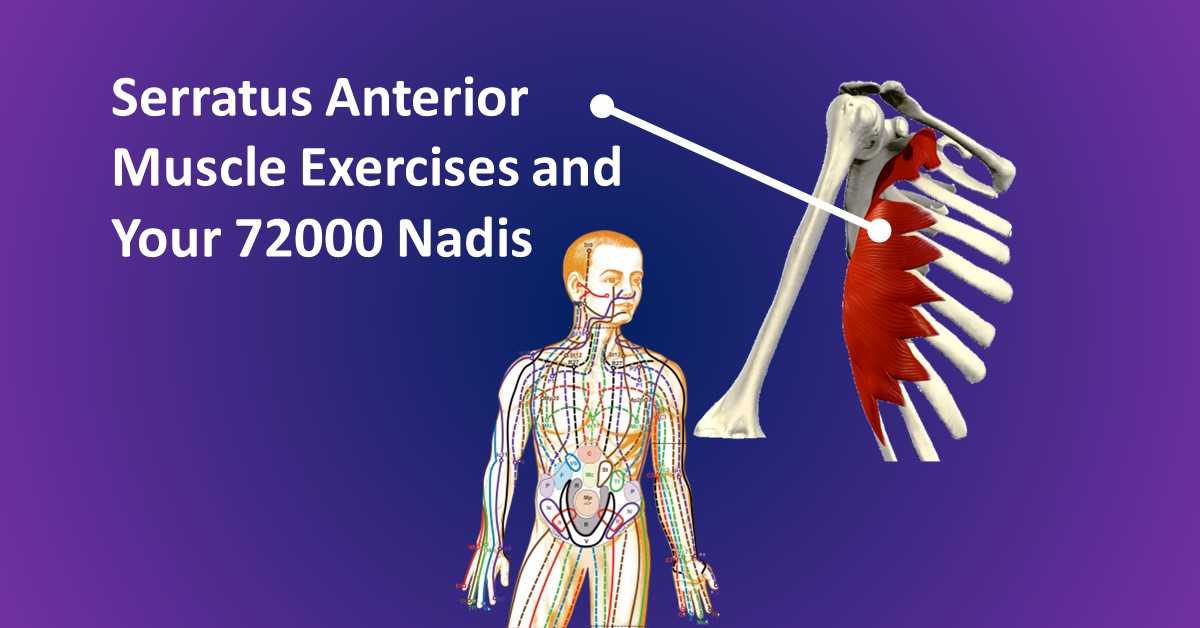The serratus anterior muscle exercises are often powerful in removing various types of blockages from the chakras and the energy bodies. It plays a pivotal role not just in physical activities but also in promoting chakra balancing and removing Nadi-related energy blockages in the mind-body system.
In this article, we explore the world of serratus anterior, exploring breathing techniques, stretching exercises, benefits, and crucial precautions to ensure a harmonious integration into your spiritual, mental, and physical well-being.

In the Sri Amit Ray traditions of the Ray Advanced Kriya Yoga system, like the soleus muscle, Serratus Anterior Muscle, the levator scapulae muscle has many subtle kriyas.
Serratus Anterior Muscle
The serratus anterior is a fan-shaped muscle located on the lateral aspect of the rib cage. It originates from the surface of the upper eight or nine ribs and inserts into the anterior surface of the medial border of the scapula (shoulder blade). In some traditions of ancient yoga, it is considered that the serratus anterior muscle alignment holds the key to eternal youth. While traditionally associated with pushing movements, unlocking its potential as a breathing muscle can bring about a host of benefits.
Serratus Anterior Muscle and Your Chakras and Nadis
In 2005, His Holiness Sri Amit Ray discovered the 114 chakras to understand the total neuropsychology, human mind, body, and spiritual energy the body experiences. He introduces the names, locations, functions, mantras, and techniques for awakening of the 114 chakras. Among the 114 chakras, a set of chakras is associated with the serratus anterior muscles. Similarly, a group of energy channels (Nadis) are associated with the serratus anterior muscles. The concept of 114 chakras offers a unique and innovative perspective on the understanding of the body-mind-consciousness energy centers in the human body.
Each of these chakras could have specific functions, including the regulation of emotions, the facilitation of physical well-being, and the enhancement of spiritual awareness. In the tradition of the 72000 Nadis System originated by Sri Amit Ray, exercises that focus on the serratus anterior are vital for balancing the Ida and Pingala and activating the Sushumna Nadi in the spine.
Nadis are subtle energy channels that crisscross the body, carrying the life force known as Prana. It is believed that there are 72,000 Nadis forming an intricate network, influencing physical, mental, and spiritual well-being. The activation and harmonization of these Nadis are central to practices like Yoga and Ayurveda.
The serratus anterior, through its engagement and release during specific exercises, may influence the flow of Prana through the Nadis. As the muscle contracts and relaxes, it creates a dynamic energy exchange, potentially enhancing the vitality of these energy channels. In the Sri Amit Ray traditions of yoga suggest that a balanced and free-flowing life force (Prana) contributes to overall health, heightened awareness, emotional stability, and total spiritual growth.
Serratus Anterior Muscle Exercises
The serratus anterior exercises include shoulder extension, forward punch, serratus anterior punch, dynamic hug, scaption (with external rotation), press-up, push-up plus, and knee push-up plus [1]. Rowing exercises have been recommended for strengthening the trapezius muscle [2]. The standard push-up plus provides a dynamic way to target and strengthen the serratus anterior muscles, contributing to improved shoulder function and overall upper body strength [3].
1. Standing Lateral Stretch:
Instructions:
- Stand with your feet hip-width apart, maintaining a straight posture.
- Lift one arm over your head, reaching towards the opposite side.
- Grasp your wrist with the hand of the opposite side.
- While gently pulling the wrist, engage the muscles on the side you’re stretching.
- Simultaneously, press down with the foot on the side you’re stretching to intensify the stretch.
- Feel the elongation along your side body, emphasizing the stretch on the ribs.
Benefits:
- Targets the serratus anterior muscle, promoting flexibility in the ribcage.
- Enhances the range of motion in the side body.
- Alleviates tension in the ribs and promotes a sense of openness.
2. Doorway Rotational Stretchs:
Instructions:
- Find a doorway or a sturdy pole and stand beside it.
- Place your hand on the surface slightly higher than shoulder height.
- Rotate your body away from the hand on the door, feeling a stretch in your chest and shoulders.
- Simultaneously, focus on opening up the rib cage, engaging the serratus anterior muscle.
- Hold the stretch for a comfortable duration, feeling the gentle release.
Benefits:
- Targets the serratus anterior while also stretching the chest and shoulders.
- Improves thoracic mobility by opening up the rib cage.
- Aids in relieving tightness in the upper body.
3. Pole Twist Stretch:
Instructions:
- Using the same doorway or pole, hold onto it slightly higher than shoulder height.
- Roll your body away from the pole, twisting towards the opposite direction.
- Feel the stretch along the side of your ribcage, emphasizing the engagement of the serratus anterior.
- Maintain a controlled and comfortable stretch, avoiding excessive force.
- Breathe deeply to enhance relaxation and deepen the stretch.
Benefits:
- Targets the serratus anterior from a different angle, enhancing overall muscle flexibility.
- Encourages a rotational stretch, beneficial for spinal mobility.
- Promotes a sense of openness and relaxation in the upper body.
Breathing Exercises for Serratus Anterior Activation
1. All-Fours Breathing Exercise:
- Start in an all-fours position, resting on your elbows with palms facing up.
- Keep your toes flexed, creating a stable foundation on your knees and toes.
- Sink back, bringing your ribs down towards your pelvis.
- Inhale slowly through your nose, directing the breath into your mid and upper back.
- Exhale deliberately, visualizing your ribs moving downward and reaching your elbows into the floor.
Serratus Anterior Yoga Exercises:
- Tadasana (Mountain Pose):
- Engage the serratus anterior by reaching the arms overhead with palms facing each other.
- Emphasize the protraction of the scapula to activate the muscle.
- Hold the pose for 30 seconds to 1 minute, focusing on deep and intentional breathing.
- Chaturanga Dandasana (Four-Limbed Staff Pose):
- During the descent, protract the scapula to engage the serratus anterior.
- Maintain the engagement as you transition through upward and downward-facing dog.
- Repeat this sequence for 5 rounds.
- Vrikshasana (Tree Pose):
- Extend the arms overhead with fingers reaching towards the sky.
- Incorporate serratus anterior engagement by protracting the shoulder blades.
- Hold the pose for 30 seconds on each leg, breathing consciously.
Benefits of Serratus Anterior Activation
1. Improved Posture:
- Strengthening the serratus anterior aids in maintaining proper shoulder alignment, promoting better overall posture.
2. Reduced Neck and Shoulder Tension:
- Activating this muscle as a breathing aid can alleviate tension in the neck and shoulders.
3. Enhanced Scapular Movement:
- Serratus anterior activation contributes to smooth and controlled movement of the scapula, crucial for shoulder health.
4. Increased Thoracic Mobility:
- Incorporating serratus anterior exercises enhances mobility in the mid and upper back, fostering a more flexible thoracic spine.
Precautions for Serratus Anterior Exercises
While these exercises offer numerous benefits, it’s essential to approach them with caution to prevent injury:
1. Start Gradually:
- Begin with lighter exercises and gradually progress to more challenging ones.
2. Mindful Breathing:
- Pay attention to your breath, ensuring it is controlled and directed into the targeted muscle.
3. Consult a Professional:
- If you have existing shoulder or back issues, consult a fitness professional or healthcare provider before incorporating new exercises.
4. Proper Form:
- Maintain proper form during exercises to prevent undue stress on surrounding muscles and joints.
Tips for Stretching Experience:
- Breathe Mindfully: Inhale deeply through your nose, allowing your ribcage to expand, and exhale slowly to enhance the stretching experience.
- Listen to Your Body: Respect your body’s limits, and avoid pushing into pain. Gradually deepen the stretches as your flexibility improves.
- Consistency is Key: Include these stretches regularly in your routine to experience long-term benefits and improved flexibility.
The BottomLine
Embark on this journey of authentic stretching, and let your serratus anterior revel in the newfound flexibility. These stretches not only target a specific muscle but also contribute to an overall sense of well-being, promoting a mobile and supple upper body. Stretch, breathe, and embrace the transformative power of authentic flexibility exercises, and chakra energy balancing.
The serratus anterior is not merely a muscle responsible for shoulder mechanics; it holds the potential to bridge the physical and energetic realms within the body. You can use the transformative power of the serratus anterior by doing specific breathing exercises, and practicing yoga stretching exercises. This will help them become stronger, more stable, and make sure that vital energy flows smoothly through the complex web of the 72000 Nadis.

